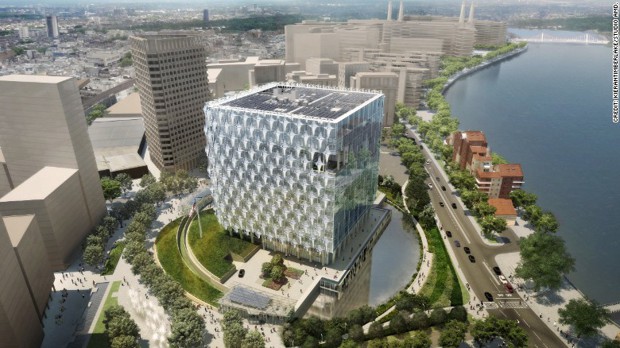
(National Security Agency)
The Dark Architecture of National Security
From the mirrored fortress of the NSA headquarters to the new U.S. Embassy in London, the built environment of the security state reflects our national anxieties.
All that is known about this photo for sure is that it was taken after 1986. The Headquarters Building for the National Security Agency is the one in the back, a modest nine-story structure that resembles an anonymous apartment complex. It was completed in 1963; the lower, mall-shaped building, Operations Building 1, predates it by a decade. The more prominent towers—a pair of blue-black boxes, Operations 2A and 2B, clad in copper to block electromagnetic signals, like a Faraday cage—were finished in 1986.
That much is knowable thanks to a 2012 document published by the NSA for its 60th anniversary. The agency itself would not confirm when the buildings had been finished (or if they even were), according to Jack Self, a writer for the U.K. magazine Dezeen who dug into the history of the NSA campus a couple years back, revealing the unlikely architects behind the structures.
Mirrored and forbidding, the NSA campus stands as a fortress surrounded by a moat of parking. The public knows almost nothing about what happens inside: As Self writes, “the authorised information available on the building could practically be published in a single tweet.”

A 2007 photo of the National Security Agency Headquarters Building, which was built in 1963. (Charles Dharapak/AP)
The NSA dominated headlines this week after The Intercept published agency documents on June 5 that detailed Russian efforts to hack the 2016 election. An hour after the story went live, the FBI arrested Reality Winner, an intelligence contractor and the alleged source of the leaked report. Winner, who may be released on bond on Thursday, is expected to plead not guilty to charges of “removing classified material from a government facility and mailing it to a news outlet.”
Photos of Winner, a 25-year-old woman who lives in Augusta, Georgia, are circulating widely. So is the official photo of the NSA campus in Fort Meade, Maryland—one of the most striking architectural images of the moment. It is a reminder that the built environment of the security state has taken dark turns over the last 30 years.
There is a through-line from the federal government’s most secretive and ominous buildings to its most noble and idealistic ones. The NSA’s Operations 2A and 2B buildings were designed by Eggers and Higgins, a New York architecture firm named after Otto Eggers and Daniel Higgins—the architects who completed the National Gallery of Art and the Thomas Jefferson Memorial. (The firm has since changed names through mergers and acquisitions. Eggers and Higgins were longtime associates of John Russell Pope, the original designer of these classical projects; Pope died before they were constructed.)
The NSA headquarters building is as compelling as it is unsettling—much like the J. Edgar Hoover Building, the headquarters for the FBI. The hundreds of cars parked around the building stand in for the thousands of intelligence workers inside—the serfs of the deep state, as it were. The photo anonymizes them: It’s not possible to make out the make or model of most of the vehicles, much less any information about the lives of the employees who drive them. Dots of colors of vehicles reflected in the mirrored building envelope betray nothing about what happens inside. Fort Meade looks like it might be the end of the earth, an exurb you never hope to have reason to visit. Like the FBI Building, the NSA headquarters is a metaphor for the agency it hosts.

The Bureau of Alcohol, Tobacco, Firearms and Explosives headquarters, pictured in 2008. (Ketzirah Lesser and Art Drauglis/Flickr)
The Bureau of Alcohol, Tobacco, Firearms and Explosives headquarters in Washington, D.C., is another piece of security architecture with a design pedigree. It was built by Moshe Safdie, who is best known for designing Expo 67 in Montreal and Crystal Bridges in Bentonville, Arkansas. Elsewhere in D.C., he designed the U.S. Institute of Peace, a building that is more frequently mentioned in connection with Safdie’s name locally than the ATF Building.
But the latter is absolutely more distinctive, especially as an example of security theater in the built environment. ATF’s headquarters, completed in 2008, was the first to abide by new security standards set forth for federal buildings after the Alfred P. Murrah Federal Building bombing in Oklahoma City in 1995. Blast-resistant glass is a defining feature, as are deep setbacks—a “landscaped demilitarized zone between the building and the street,” as critic Witold Rybczynski once put it. Much of the ATF campus is given over to pure design: Two giant arching wings form a crescent “garden wall” along the north and west sides of the building, which face out to the busy intersection of New York and Florida Avenue NW. (A grave concern, then and now: As far back as 2003, al Qaeda was pledging that “cars of death” would rain destruction down on D.C.)

The Embassy of the United States in London, designed by KieranTimberlake. (KieranTimberlake)
A paranoid style is easy to spot in even the more sophisticated national security designs from the post–9/11 era. Consider the forthcoming U.S. Embassy in London, a $1 billion landmark designed by KieranTimberlake. While (soon-to-be former) Rep. Jason Chaffetz described the project’s glass curtain wall as “opulent looking,” his comments came during a discussion about whether Congress could rely on claims that this façade would be utterly blast proof. As my colleague Amanda Kolson Hurley explains for CNN, critics say that the embassy—which also gets its own moat—is too forbidding. The architecture of the security state is awesome: terrible in its implications, but also an almost poetic reflection of national anxiety.

